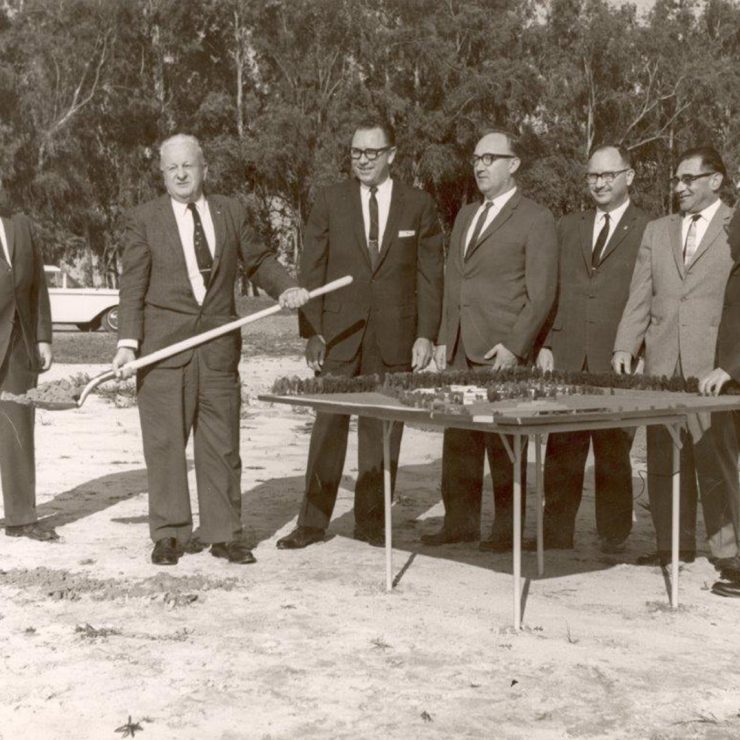History
And Now We’re 60!
One hundred years after Merced County was formed in 1855, students were having to travel out of the county to go to college, including community college. Merced County was not part of any community district. This meant Merced County had to pay a fee for each of its residents attending a community college such as Modesto Junior College. A survey conducted by the State Department found that a Merced County Community College was desirable and recommended that an election be held to form a district.” (Inferno Redoux) After many meetings and discussions, Merced Union High School District called for a meeting to vote on whether the high school districts would support the construction of a community college. Only two of the high school districts voted to approve the concept and cause an election to determine the new college district’s fate: Merced Union High School and LeGrand High School. The vote, held on February 27, 1962, was 3996 in favor and 1494 against. The new college district was created and the stage was set for the next steps.
How it Began
Groundbreaking of the main campus.
More History and Information
Prior to the finding of gold in California, the central San Joaquin was a pristine place. The wild clover grew taller than a horse’s head; the streams teemed with salmon, bass, and trout; and grizzly bears and antelope roamed far and wide. The early inhabitants of the valley were the Northern Valley Yokuts, who roved the entire floor of the San Joaquin Valley and were estimated to number around 30,000. In an 1806 expedition, Ensign Gabriel wrote of finding a welcomed river to quench the expedition’s thirst. He named it El R¡o de la Nuestra Se¤ora de la Merced, the river of mercy. When the gold seekers overran the area on the way to the gold field, times changed.
Finally, when California became a state in 1850, Mariposa County covered much of the central valley, extending to a mutual boundary with San Diego and Los Angeles counties. In 1855, farmers of the lowlands decided they did not have much in common with the miners of the foothills and mountains and petitioned to have a section split off to form a new county. When the petition was granted, Merced County was formed by Governor John Bigelow on April 19, 1855. On 1857 tax assessment rolls, the new county boasted of a population of 277. The first county seat was in Snelling. Once the railroad came through the county, much of the business and the county seat moved to the new town of Merced, which incorporated in 1889.
For Merced County the growth, and the change coming with it, has continued.
The Merced Community College District is composed of most of Merced County, the area of the Chowchilla Union High School District in Madera County, and the Dos Palos Joint Elementary School District. The Governing Board is made up of seven elected members.
The Beginnings of the College District Merced College is a California Public Community College operated by the Merced Community College District, which was formed by a vote of the people of the Le Grand and Merced Union High School Districts on February 27, 1962. The District, which comprised the eastern half of Merced County, consisted of the areas served by these two high school districts. The Governing Board consisted of five members elected at large in the District. The first members of the Board, elected in May of 1962, were as follows: Buddy T. Iwata, Chairman; George W. Clark, Vice C hairman; Byron Cunningham, John R. Hann, and Donald Robinson.
The Merced Community College District became effective for all purposes July 1, 1963.
Educational success is the college’s commitment to each student. Merced College strives to make students aware of our varied educational programs. The college provides many services to ensure success.
All students who enroll in credit courses “matriculate.” Matriculation is a process that brings Merced College and each student into an agreement for the purpose of realizing the student’s educational objectives.
Within the State Matriculation Plan, Merced College provides: An admissions process; An assessment of basic educational skills and career goals; Pre-enrollment counseling/advising and course selection; An orientation to college programs, services, and procedures; A suitable curriculum or program of courses; Quality instruction; Continuous follow-up on student progress with referral to support services when needed.
As part of the Matriculation Plan, students agree to: Express a broad educational intent at the time of admission; Declare a specific educational objective within a reasonable period of enrollment; Complete the assessment process; Confer with counselors for registration approval and discussion of educational and vocational choices; Meet with a counselor to develop an educational plan once 15 units of course work have been completed; Attend classes and complete assigned course work; Seek out support services as needed; Complete courses and maintain progress toward an educational goal.
Merced College is fully accredited by the Western Association of Schools and Colleges, and is approved by the State Department of Education to train veterans under provisions of the G.I. Bill of Rights, and by the United States Immigration Service. The college offers a lower division program consisting of courses paralleling those of four-year colleges and universities, the credits for which are transferable to all other accredited colleges and universities.
Merced College is a member of the Central Valley Higher Education Consortium (CVHEC). The mission of the Central Valley Higher Education Consortium is to provide effective leadership that promotes programs, policies, and performance designed to increase higher education attainment by the people of the Central Valley. http://www.collegenext.org
